
April 2013
Promise and Betrayal
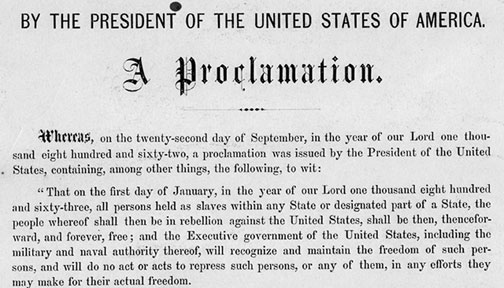
The promise: “thenceforward, and forever, free.” But soon subjected to wage
slavery, lynching and denial of fundamental democratic rights.
The 150th anniversary of the Emancipation Proclamation – by which President Abraham Lincoln unilaterally freed more three million slaves in the Confederacy on 1 January 1863 – went by with as little public acknowledgement as possible this year. This was to be expected. In his first inaugural speech, Barack Obama had managed to avoid mentioning “dangerous” topics such as race, racism, integration or civil rights in any way, shape or form. His second inaugural address, this past January, was larded with snippets from Lincoln and Martin Luther King.
But Obama evoked the Civil War only to declare: “We made ourselves anew, and vowed to move forward together.” Really? What about lynching and Jim Crow segregation? One hundred years after the Proclamation, the nation was again being shaken by the Civil Rights movement – the struggle to regain elementary formal democratic rights such as the right to vote in the South. Even Lyndon Johnson had to declare in 1965, “A century has passed since the day of promise, and the promise is unkept.”
This “wasn’t-it-tragic” dismissal of the Civil War, burying not only the question of slavery but also of on-going racial oppression, has been the official ideology of American capitalism at least since the end of Reconstruction in 1877. Today Obama’s platitudes have as their backdrop the presidentially-ordered drone assassinations, his quota-driven deportation of millions of immigrants, and a “debate” about gun control in which both sides agree on stepped-up racist police terror.
Disappearing a
Revolution
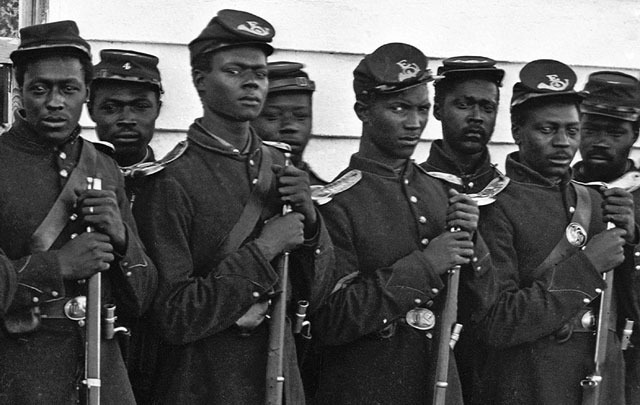
The abolition of slavery was achieved by victory on the Civil War battlefields, where the recruitment
of black soldiers was the turning point.
The signing of the Emancipation Proclamation, unlike the Declaration of Independence of July 4, 1776, was never going to be a holiday in racist, imperialist America. The first bourgeois-democratic American revolution involved simple political separation from Great Britain and was not fought over fundamental social issues. If anything, it only reinforced the power of the slaveholders in the South. (In some places, the British freed slaves belonging to rebels against the Crown.)
Only a few voices were raised urging the extension of the rights claimed in the Declaration of Independence to the colonists’ human property. The great black abolitionist Frederick Douglass could thus bitterly ask, in his 1852 speech, “What to the Slave is the 4th of July?” Likewise, Marxists today do not join in the patriotic celebration of American independence.
The second American Revolution – the Civil War – was quite another matter. It involved a struggle against a type of exploitation of labor created by a previous form of merchant capitalism (“primitive capitalist accumulation”) which was proving a barrier to the consolidation of industrial capitalism based on wage labor. Although it did not consummate a social revolution overthrowing capitalist rule (at the time industrial capitalism in the U.S. was poised for a vast expansion, while the workers movement was in its infancy), in smashing slave relations of production the Civil War went beyond political rights to pose questions of property.
Just as the French bourgeoisie cannot simple renounce the French Revolution without renouncing the whole framework of bourgeois democracy, the U.S. bourgeoisie cannot simply denounce the struggle against slavery without standing naked to the world. But it can and does revile the Nat Turners and John Browns and ignore or trim down other abolitionist fighters, just as the French bourgeoisie denounces the “excesses” and “fanaticism” of its Revolution and the egalitarian aspirations it awoke.
In the U.S. rulers’ campaign of historical amnesia, the issue of how slavery was abolished tops the list of events to be mystified. Beyond all the references to the political genius of Lincoln, at bottom it was a conflict of two very different forms of capitalism. Karl Marx recognized from the outset:
“One sees, therefore, that the war of the Southern Confederacy is in the true sense of the word a war of conquest for the spread and perpetuation of slavery....
“The present struggle between the South and North is, therefore, nothing but a struggle between two social systems, the system of slavery and the system of free labor. The struggle has broken out because the two systems can no longer live peacefully side by side on the North American continent. It can only be ended by the victory of one system or the other.”
–Karl Marx, “The Civil War in the United States” (November 1861), reprinted in the Internationalist Group Class Readings, Marx on Slavery and the U.S. Civil War (second edition, April 2009)
Frederick Douglass reached a strikingly similar conclusion:
“The American people and the Government at Washington may refuse to recognize it for a time; but the ‘inexorable logic of events’ will force it upon them in the end; that the war now being waged in this land is a war for and against slavery; and that it can never be effectively put down till one or the other of these vital forces is completely destroyed.”
–Douglass’ Monthly (May 1861), quoted in James McPherson, The Negro’s Civil War (Ballantine Books, 1991)
Abraham Lincoln was a towering historical figure, as the leader of one of the great bourgeois revolutions. But he was able to fulfill that role because the contradiction between two variants of capitalism – those based on slave labor and “free” wage labor – had come to a head, and a showdown could no longer be postponed. As Marx underlined in his famous “Address of the International Working Men’s Association to Abraham Lincoln” (November 1864):
“…the working classes of Europe understood at once, even before the fanatic partisanship of the upper classes for the Confederate gentry had given its dismal warning, that the slaveholders’ rebellion was to sound the tocsin for a general holy crusade of property against labor, and that for the men of labor, with their hopes for the future, even their past conquests were at stake in that tremendous conflict on the other side of the Atlantic.”
Millions of Americans are taught the fiction that Lincoln abolished slavery with a stroke of the pen. That, of course, leaves out the fundamental issue – the Civil War – which made slave emancipation necessary for Northern victory. It is true that the Proclamation exempted the slaves in the Border States such as Kentucky which were not in open rebellion and even some major slaveholding centers occupied by the Union such as New Orleans. Yet this Proclamation and the enrolling of 180,000 ex-slaves in the Union army marked the turning point, after which the slaveocracy was doomed – not because of a perfect law but as part of a revolutionary struggle.
Steven Spielberg’s contribution to the anti-revolutionary rewriting of American history, Lincoln (see accompanying article), came out last fall in anticipation of the Proclamation’s 150th anniversary. The movie edits out Lincoln’s revolutionary deeds by focusing solely on the 13th Amendment to the Constitution, which formally and definitively did away with slavery, reducing even the passage of this amendment to a series of sordid backroom deals in the process. Ignoring or distorting the role played by slaves themselves, by the abolitionists and even the Union army to concentrate on Lincoln as a solitary figure is a huge falsification of history.
It does not even do justice to Lincoln himself, for the Proclamation represents a break with his previous views, which anticipated the freeing of the slaves state-by-state, with compensation, some time in the future. In the first year of the Civil war, Lincoln refused to proclaim emancipation and allow the recruitment of black troops. He finally relented to pressure from abolitionist leaders, Radical Republicans, and Union officers, announcing his intentions in September 1862 before actually issuing the Proclamation. This marks the official beginning of a flowing black tide into the Union forces.
At the same time, the freeing of the nearly 4 million slaves meant expropriation without compensation of more than $3.5 billion worth of property, more than the entire worth of U.S. manufacturing, railroads, ships and banks combined! In terms of the share of the gross national product at the time, this would be the equivalent of over $10 trillion in the U.S. economy today.
Furthermore, the Emancipation Proclamation, the 13th Amendment and the “Reconstruction Amendments” – the 14th Amendment (1868, granting citizenship to all those born in the U.S.), and the 15th Amendment (1870, granting black men the right to vote) – were the outcome of real, armed struggles. From John Brown’s victory over pro-slavery terrorists in Kansas (1856) to the great battles of the Civil War to the military-political actions of the Reconstruction period, not a single essential right was won, truly won, through the passage of a law.
Reforms, as Lenin pointed out, are often the partial outcome of determined revolutionary struggle; reformism as a strategy for the oppressed is self-defeating. None of the civil rights laws of the 19th century ultimately protected blacks from subjection to the sharecropping system, nor from the complete denial of their democratic rights in the period between the defeat of Reconstruction (1877) and the Civil Rights and black liberation movements of the 1960s. And now even those limited gains are being systematically rolled back.
Slavery and
Capitalism
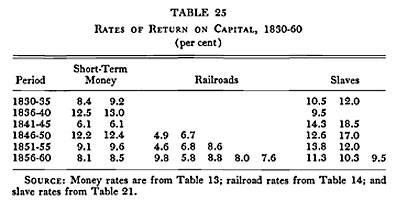 Slavery in the United
States was a capitalist
enterprise, and a profitable one.
The National Bureau of
Economic Research published a
study on the comparative annual
rate of return on capital for
slave owners and other
investments, using alternative
measurements. From Robert Evans
Jr., The Economics of Negro
Slavery (1962).
Slavery in the United
States was a capitalist
enterprise, and a profitable one.
The National Bureau of
Economic Research published a
study on the comparative annual
rate of return on capital for
slave owners and other
investments, using alternative
measurements. From Robert Evans
Jr., The Economics of Negro
Slavery (1962).
Slavery in the U.S. was a bourgeois institution – entirely a part of the U.S. and world capitalist system. As early as 1847 Marx wrote in The Poverty of Philosophy, “Direct slavery is as much the pivot upon which our present-day industrialism turns as are machinery, credit, etc.” He would later define the contradictory nature of the slave regime in the Grundrisse, his notes in preparation for Capital: “The fact that we now not only call the plantation owners in America capitalists, but that they are capitalists, is based on their existence as anomalies within a world market based on free labor.”
The slaveholders’ power was enshrined in the U.S. Constitution and their male children formed the greater part of the officer corps of the U.S. Army. In the first half of the 19th century, this oligarchy extended its slaveholding empire across the Mississippi as far north as Missouri through the Louisiana Purchase. It then moved into Texas and was instrumental in launching the invasion of Mexico in 1845. That sordid conquest ripped away from Mexico (where slavery was illegal) an area that is now the western U.S., from Texas to California.
Marx explained, however, that as the manufacturing economy based on wage labor grew in the United States, with its concomitant small-holder farms, the leaders of the agricultural South based on slave labor became increasingly alarmed and belligerent. While the rice, tobacco, and cotton produced by the slave economy were destined for the capitalist market, the “oligarchy of 300,000 slaveholders,” as Marx called them, began to clash with Northern society.
In a series of letters written in 1861-62 to Die Presse in Vienna, Marx laid out the essential economic and political logic of the slave system’s expansionism:
- First, the 300,000 slaveholders also lorded over a mainly poor white population of five million, which had little material interest in the continuation of slavery (although often economically dependent on and ideologically subservient to the slave masters). To keep this restless and hungry white population in thrall, the slavocracy promised the poor whites new land and even possible eventual status as new slaveholders. Only with new slave states and territories could this promise be fulfilled.
- Second, the production of export crops (cotton, tobacco, sugar) by the slave system was threatened due to soil depletion in Virginia, Maryland and even South Carolina. The slavocracy’s profits in these states were coming more and more from slave raising and the provision of slaves to other slave states. The market for slaves in the other states was limited, and so the expansion of slavery into other areas where extensive cultivation could be undertaken was imperative. (Thomas Jefferson had foreseen this problem long ago, and as governor of Virginia in 1780 organized military expeditions to exterminate the native population and push the borders of his state westward.)
- Third, the slavocracy needed more slave states to maintain its political power in Washington. While the American political system had always favored the slaveholders, Northern capitalism was forging ahead. The political power deriving from it would soon overwhelm that of the South, despite the odds, unless this was checked by the addition of new slave states. While the House of Representatives, based proportionally on the white male population, would remain in Northern hands, the Senate (where the better part of U.S. legislative power resides) was and is non-proportional – every state no matter its population was (and still is) given two senators. Accordingly, parity (at least) between slave and free states had to be maintained there.
Abolitionism, Pacifist and Militant
The outcome of the Mexican War had doubled the size of the United States, and the slaveholders were gaining in their design of creating a slaveholding continent. The Fugitive Slave Law was passed in 1850 and enforced by Federal troops (so much for “states rights”). The slavers threatened also to expand their system into every new territory and state in the United States, no matter how far west or north. Twenty years of pacifist appeals to the slaveholders’ “Christian consciences” by William Lloyd Garrison and his reformist abolitionist followers were completely wiped out. Any abolitionist with eyes to see realized that further pacifism would be useless now.
The answer came from Kansas, a disputed territory with an election nearing that would determine whether it would be slave or free upon entering the Union as a state. A campaign of terror was waged against the Kansans, who were mostly against slavery, by racist gangs from neighboring Missouri known as the “Border Ruffians.” Then in 1855 John Brown arrived. He brought with him a disciplined multiracial battalion of revolutionists that included “Red 48ers” – veterans of the defeated 1848 revolutions in Germany and Italy. Under Brown’s political and military direction, the settlers were armed and trained. They proceeded to beat back the racists in several bloody battles and Kansas was soon free. It was a powerful demonstration of what it would take to overthrow slavery.
Against this backdrop, the Republican Party, newly formed on the basis of the former Free Soil Party, pledged itself to blocking the expansion of slavery entirely. The first Republican candidate for president, in the 1856 elections, had been the open abolitionist General John C. Frémont. Though he lost to Democrat James Buchanan, an apologist and abettor of slavery who ran as a “moderate,” Frémont made a strong showing.
By 1860, the 300,000 slaveholders intended to turn the U.S. presidential elections into a referendum on rebellion – the only rebellion in modern history, Marx pointed out, whose rallying cry was “slavery!” As a moderate Republican, Lincoln was opposed by the Radicals (who initially favored William Seward). Nonetheless, Lincoln’s decisive victory in the general election against a divided pro-slavery opposition became the signal for the slavers’ rebellion. The slaveholding cabal forced each Southern state, one by one, to disclaim the Union. They formed their “Confederate States of America” as an armed camp, seizing Federal property, especially forts, ships and arms. The poor white population, hesitant in many areas, was mobilized around “Southern honor” and “states’ rights” to fight to the death for slavery and white supremacy.
Secession and
All-Out War
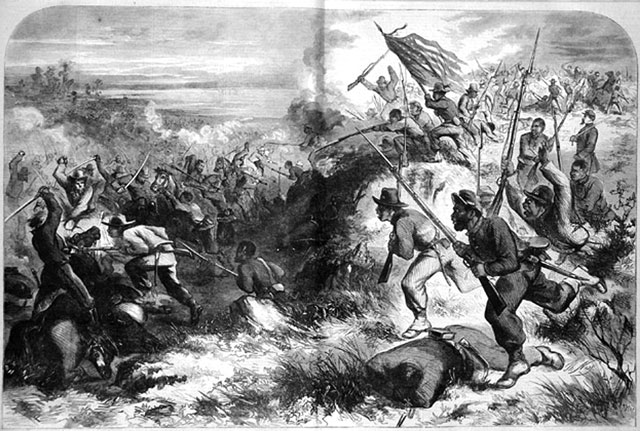
Above: “A Negro Regiment in Action.” Engraving by Thomas Nast, from Harper’s Weekly, 14 March 1863, depicts the battle of Island Mound, Missouri. The troops of the First Kansas Colored Volunteer Infantry, most of them escaped slaves from Arkansas and the Oklahoma Territory, fought off a charge by Confederate cavalry on 29 October 1862 in the first engagement in which black troops were used in the Civil War. Below: Frederick Douglass’ March 1863 speech, “Men of Color to Arms!” was used by African American leaders for recruiting poster to enlist black volunteers to join the army to fight against slavery.
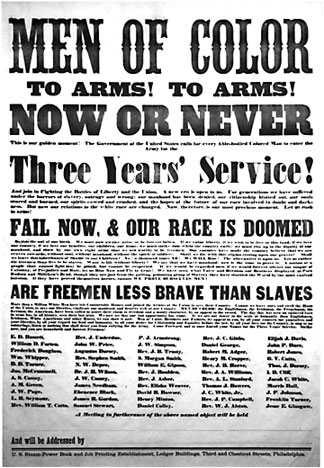 In office, Lincoln
attempted to retain the loyalty of the
slaveholders in the so-called Border
States (Kentucky, Delaware, Maryland),
and refused to proclaim the overthrow of
slavery. He even re-imposed slavery in
Missouri in 1861 after Frémont, then
commander of the district, issued an
order of emancipation. Nonetheless,
Lincoln did not recognize a right of
secession and insisted that the United
States retained possession of all the
rebel territory. And even with the
original, limited war aims, recovery of
the South required dislodging the
slavocracy, which meant all-out Civil
War.
In office, Lincoln
attempted to retain the loyalty of the
slaveholders in the so-called Border
States (Kentucky, Delaware, Maryland),
and refused to proclaim the overthrow of
slavery. He even re-imposed slavery in
Missouri in 1861 after Frémont, then
commander of the district, issued an
order of emancipation. Nonetheless,
Lincoln did not recognize a right of
secession and insisted that the United
States retained possession of all the
rebel territory. And even with the
original, limited war aims, recovery of
the South required dislodging the
slavocracy, which meant all-out Civil
War.
Even as the rebellion armed, the U.S. was ill prepared for war. The tepid quality of the initial Northern war effort was incarnated by General George B. McClellan. McClellan owed his position to pressure from the pro-slavery Democrats and sought to preserve the Union “as it was” (i.e., without touching slavery), while he and his staff were close to the rebel officers of the Confederacy. In response to the string of Union defeats, Marx remarked in a letter to Friedrich Engels of 10 September 1862: “In regard to the North’s conduct of the war, nothing else could be expected from a bourgeois republic, where swindle has been enthroned for such a long time.”
As Union losses mounted, Lincoln’s resolve, bolstered by the increasing resolve of the Northern workers and farmers who were doing the fighting, hardened around the understanding that no compromise could be made with the slavocracy and a Northern victory required smashing the slave system. In “A Criticism of American Affairs” (9 August 1862), Marx observed:
“New England and the Northwest, which have provided the main body of the army, are determined to force on the government a revolutionary kind of warfare and to inscribe the battle-slogan of ‘Abolition of slavery!’ on the star-spangled banner. Lincoln yields only hesitantly and uneasily to this ‘pressure from without,’ but he knows that he cannot resist it for long….
“So far, we have only witnessed the first act of the Civil war – the constitutional waging of war. The second act, the revolutionary waging of war, is at hand.”
Lincoln ultimately secured competent military leadership in generals Ulysses S. Grant and William Tecumseh Sherman who, like Lincoln himself, adopted a more revolutionary approach to waging the war out of pure pragmatism.
Lincoln’s attitude was summed up in a 22 August 1862 letter to Horace Greeley, editor of the New York Tribune:
“My paramount object in this struggle is to save the Union, and is not either to save or to destroy slavery. If I could save the Union without freeing any slave I would do it, and if I could save it by freeing all the slaves I would do it; and if I could save it by freeing some and leaving others alone I would also do that.”
Yet even as he wrote that, Lincoln had concluded that freeing the slaves and enlisting black troops (both free and ex-slave) was decisive to winning the war. He already had a draft of the Emancipation Proclamation in his desk drawer. One month later he released it.
Emancipation and Radicalism
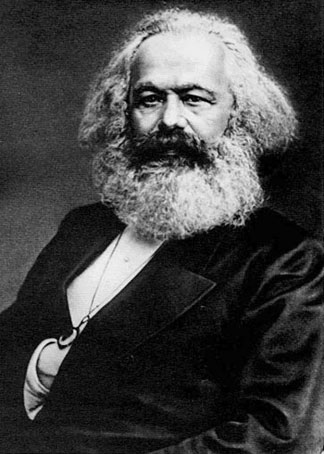 Karl
Marx
Karl
Marx
The announcement of the impending Proclamation had an electrifying effect on the abolitionist movement that had fought for it. Frederick Douglass wrote that “the proclamation … is the most important of any to which the President of the United States has ever signed his name” (“Emancipation Proclaimed,” Douglass’ Monthly, October 1862). Likewise, Karl Marx wrote, in Die Presse, 12 October 1862, that “his most recent proclamation – the Emancipation Proclamation – [is] the most significant document in American history since the founding of the Union and one which tears up the old American Constitution.”
Douglass’ immediate demand was to “let the black man have an arm as well as a heart in this war, and the tide of battle which has thus far only waved backward and forward, will steadily set in our favor.” Marx recognized this also, and argued (in a letter to Engels of 7 August 1862) that the organization of even a single black regiment “would have a remarkable effect on Southern nerves.” In fact, black recruitment had already begun. Lincoln’s proclamation meant that history’s tide had turned and slavery was doomed.
This was understood by Douglass and all the “Radicals” – a loose term then referring to all those within and outside the Republican Party who were well aware that slavery was at the center of the conflict and were advancing a program for its complete destruction and for full political rights and economic well-being for the liberated blacks. While Thaddeus Stevens, Charles Sumner and other Radicals in Congress fought to pass the enabling legislation, they knew that abolition would be won on the battlefield. Douglass, closely allied with Sumner, thus waged a furious campaign to organize more and more black regiments.
Nearly 200,000 blacks served under arms, comprising over 10 percent of the Union Army; nearly 50,000 fell during the war, and a higher number were wounded. Black soldiers were under constant sentence of death. Official Southern policy was to treat them as fugitive slaves rather than as prisoners of war. If captured they could be tortured or executed by the virulently racist rebel army, as at Fort Pillow, Tennessee in 1864 when hundreds of black troops were massacred while trying to surrender by rebel forces under future KKK marauder Nathan Bedford Forrest.
But they marched with Sherman in Georgia (against Sherman’s initial opposition) and were with U.S. Grant as he cornered the rebel army at Appomattox in 1865. In retrospect, Lincoln wrote that without the black soldiers, “we would be compelled to abandon the war in three weeks.”
Uncounted African Americans, including women, also performed non-combat duties in construction, transport, supply, commissary and, crucially, reconnaissance and espionage. The great abolitionist and leader of the Underground Railroad, Harriet Tubman, became an unofficial Union battle commander, leading interracial raiding parties of Union soldiers to liberate slaves; on one raid she rescued 700 slaves from approaching rebel forces. Many of the slaves liberated by “General Tubman,” as John Brown had called her, went on to fight in the Union army or navy.
Victory and Reconstruction: “Forty Acres and a Mule”?
The fundamental questions posed by the Second American Revolution of 1861-1865 converged around land to the tiller and the arms to defend it. The formerly enslaved population needed land for cultivation and armed defense against the defeated but resurgent white supremacists. Otherwise, they would inevitably be prey to the former slave masters. This was well understood by the leadership of the Radical movement – from Harriet Tubman and Frederick Douglass to Thaddeus Stevens and Charles Sumner. Paradoxically, General William T. Sherman, who was no abolitionist and refused to accept black troops, issued the order to compensate former slaves in some areas with “forty acres and a mule,” which was later adopted by Stevens as the core of Radical Reconstruction.
In 1864, as Grant surrounded the Confederate capital of Richmond, Virginia, Sherman’s western armies dislodged the rebels from Atlanta and began their “March to the Sea.” Lincoln was initially opposed to Sherman’s strategy, but Sherman explained that it was necessary to scour out the plantations of the Deep South, which had been the engines of the slaveholders’ rebellion. With Grant’s endorsement, he took Atlanta in September, which was key to Lincoln’s reelection against the Democrat McClellan that November. Then on the heels of the elections, Sherman slashed through Georgia and South Carolina, expropriating food, burning barns and plantation houses and freeing an estimated half-million slaves from bondage, effectively destroying the South’s economic reserves and breaking the Confederates’ will to fight.
In the wake of Sherman’s army came tens of thousands of black refugees; partly to reduce their numbers, courts were sometimes improvised on liberated plantations, with land divided among the freed slaves. In January 1865 Sherman issued his “Special Field Order No. 15,” which granted coastal lands to thousands of former slaves, from Florida to South Carolina. Sherman appointed General Rufus Saxon, a leading abolitionist and organizer of black troops, to direct the settlement of blacks on their new land. Shortly after, Congress passed the 13th Amendment abolishing slavery and in March 1865 the Freedmen’s Bureau was created and authorized to divide up some confiscated lands into 40-acre plots to be distributed to ex-slaves.
After Lincoln’s assassination on 15 April 1865, only five days after Lee’s surrender at Appomattox, his successor, Andrew Johnson, soon showed himself to be a friend to the defeated slaveholders. He revoked Sherman’s field order and returned land to previous owners. He abolished the Freedmen’s Bureau and appointed proslavery governors in the Southern states under military occupation. He opposed extending the vote to newly freed black men, claiming this was up to the states. “Black Codes” which sought to bind the ex-slaves to the plantations throughout the South were imposed in 1865 and 1866 and accompanied by racist terror. In response to these outrages, abolitionists, Union officers and Radical Republicans rose up in resistance.
In Washington, control of Reconstruction was torn from the Johnson Administration and, with the Army’s help, put in the hands of Congress. The 14th Amendment (1868) and 15th Amendment (1869) were passed and some Union troops, including black troops, were activated throughout the South. Ten states of the former Confederacy were put under martial law. The Freedmen’s Bureau was reestablished and began fostering a system of free universal public education. New state governments were elected in which blacks played large and sometime majority roles. More black voters registered throughout the former rebel lands than whites. Union troops now gained the upper hand in the struggle against racist terror.
However, the land question was not resolved, at least not in favor of the former slaves. Radical Congressman George Julian fought to amend the second Confiscation Act to permit the permanent seizure of Confederates’ land. Without land, he argued, freedmen would find themselves reduced to “a system of wages slavery.” In September 1865, Thaddeus Stevens put forward a plan to seize 400 million acres from the Southern oligarchy, provide 40 acres to each freedman and sell the rest to the highest bidder (i.e., Northern investors). But as leftist historian Eric Foner notes:
“Yet to most Radicals, land for the freedmen, though a commendable idea, was not nearly as crucial to Reconstruction as black suffrage…. It is hardly surprising that many Radicals proved reluctant to support a program that so contravened the sanctity of property as confiscation….”
–Eric Foner, Reconstruction: America’s Unfinished Revolution, 1863-1877 (Harper & Row, 1988)
As a result, the former chattel slaves were reduced to wage slavery or worse, sharecropping and debt peonage. The struggle for emancipation had run into the limits of a bourgeois revolution.
The former slaveholders, led by mass murderer Nathan Bedford Forrest, met in Nashville in 1867 to enlarge the Ku Klux Klan set up by former Confederate soldiers at the end of 1865 and put the program of these death squads on a more professional military basis. As the Klan and other gangs renewed their terror campaign, President Johnson did all he could to prevent a Radical-led military response. He blocked the dispatch of troops to suppress the new rebellion and even attempted, unsuccessfully, to remove the Secretary of War, the Radical Edwin Stanton. The Radicals then successfully impeached Johnson, but fell one vote short of conviction.
Blacks armed themselves as best they could. They were given limited help by the Freedmen’s Bureau and some U.S. troops. But massacres of blacks and battles with the racist gangs continued unabated through 1868 and beyond. In the presidential elections of that year, the Radicals backed Grant, who owed his victory to the 700,000 black votes he received. During his two terms in office (1869-1877), he did attempt to fight the white supremacist movement, which had grown insurrectionary. His Radical-backed policies achieved some success against the KKK and other gangs, but not enough resources were deployed to turn the tide. Meanwhile, the bourgeois rulers were growing uneasy at the prospect of freed blacks and labor joining forces against capital, especially after the Paris Commune of 1871.
Defeat and
Counterrevolution
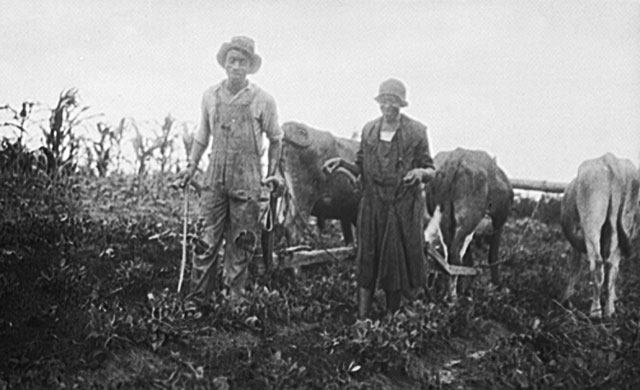
Because slaves were freed without land, many were soon subjected to “wage slavery” ... or worse. Sharecropping in Lowndes County, Alabama in 1936. (Photo: Evans Walker/Library of Congress)
In 1876 it seemed as if the promise of “forty acres and a mule” were a dream. The Freedmen’s Bureau in particular had never been empowered by its designers to suppress the racist gangs and carry through a black agrarian revolution. As historian Henry Steele Commager flatly stated during the Civil Rights movement of the 1960s, “the Government… failed the Negro. At a time when Congress set aside millions of acres for homesteaders in the West and gave over a hundred million acres to the railroad corporations, it could not summon up the generosity or the vision to give land to the freedmen” (New York Times Book Review, 13 Sept. 1964).
While Radical resolve had secured the black vote and the presidency for Grant in 1868, KKK terror played a key role in swinging the 1876 elections to the Democrat Samuel Tilden. Some white supremacists wanted to insist on Tilden becoming president, but most were willing to compromise with the Republicans. A deadly deal was worked out then, whereby the Republican Rutherford Hayes would be seated as president in exchange for the formal end of Reconstruction and the withdrawal of all U.S. troops from the South. Blacks were now forced back onto the plantations. The Democrats and Republicans united and got down to the problems of the postwar capitalist order: subjugation of black labor, extermination of the Native Americans on the plains, restriction of the Chinese immigrant workers in California, and, from sea to shining sea, assistance to the bosses in smashing the workers movement – which broke out in an insurrectionary general strike in 1877.
Ultimately, once permanent confiscation and distribution of the land to ex-slaves was excluded, Reconstruction became an unstable situation in which the ex-slaveholders retained economic domination while being excluded from actual government. And the goal of the Northern bourgeoisie in the Civil War had not been to eliminate the exploitation of blacks in the agrarian South, but rather to eliminate the excessive political power of the slaveholding class and to ensure that the fruits of this exploitation flowed into its coffers rather than those of the British.
The promise of black freedom was thus betrayed by the Northern bourgeoisie, which sacrificed Reconstruction on the altar of profit and “national reconciliation.” The counterrevolution against Radical Reconstruction was then justified in national myth: the cause of thorough-going emancipation and racial equality was buried under layers of lies so thick that generations of schoolchildren were taught – by liberal and rightist historians alike – that Reconstruction had been a terrible mistake, and even that slavery was not the underlying issue of the Civil War.
The need to fight for black liberation through socialist revolution is highlighted by the fact that the betrayal of Reconstruction meant that the Southern rulers could not only rewrite the story to suit their interests, but roll back a large part of what Reconstruction had achieved, as they pushed social relations as far back as possible towards slavery-like conditions.
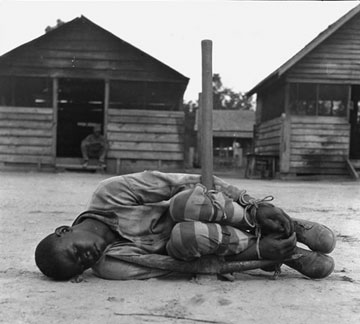 Punishment in a forced
labor camp in Georgia
in the 1930s.
Punishment in a forced
labor camp in Georgia
in the 1930s.
A number of recent works have appeared documenting just how far they were able to go in their attempts to re-subjugate black labor. Among these is Douglas A. Blackmon’s Slavery by Another Name: The Re-Enslavement of Black Americans from the Civil War to World War II (Doubleday, 2008), which shows just how massive was the use of black prison labor and other forms of coerced black labor – not only in the road-construction chain gangs depicted in innumerable films but in agriculture, coal mining and other vital parts of the Southern economy. As Blackmon observes, the judicial/prison system was configured in ways that deliberately criminalized huge sectors of the black population, while debt served as a new and very tangible shackle.
This should not suggest that the Civil War achieved nothing for the oppressed: far from it, the abolition of chattel slavery was a momentous achievement. What this does show, as we have written, is that American capitalism has racial oppression in its DNA, and whenever one form of subjugation was eliminated, a new way was soon found to deprive black people of their rights. After slavery and the democratic interval of Reconstruction, eventually the system of Jim Crow segregation was instituted in the South. And when that was formally eliminated in the 1960s, within a few years a new system was instituted of constant police-state occupation of inner-city neighborhoods and massive jailing of African American and Latino youth.
In this respect, wide attention has been drawn to the social and political functions of the vast criminalization/imprisonment system in today’s racist USA – which has the highest incarceration rate in the world – by Michelle Alexander’s The New Jim Crow: Mass Incarceration in the Age of Colorblindness (New Press, 2010). Reformists hope to address this through a “new civil rights movement” acceptable to liberal Democrats in the “age of Obama.” But the fact that American capitalism seeks one way after another to subjugate, chain and disenfranchise the black population points in the opposite direction: only the revolutionary overthrow of the capitalist system can clear the path to all-sided, real and enduring liberation.
In this task,
the building of a revolutionary workers
party as a champion of all the oppressed
is key, in which the descendants of the
slaves who fought arms in hand to crush
the slaveocracy will play a central
role. ■
To contact the Internationalist Group and the League for the Fourth International, send e-mail to: internationalistgroup@msn.com